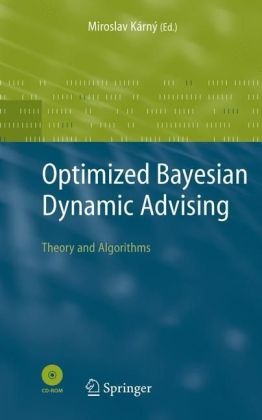Read more
A state-of-the-art research monograph providing consistent treatment of supervisory control, by one of the world s leading groups in the area of Bayesian identification, control, and decision making.
List of contents
Introduction.- Underlying Theory.- Approximate and Feasible Learning.- Approximate Design.- Problem Formulation.- Solution and Principles of its Approximation: Learning.- Solution and Principles of its Approximation: Design.- Learning with Normal Factors and Components.- Design with Normal Mixtures.- Learning with Markov Chain Factors and Components.- Design with Markov Chain Mixtures.- Sandwich BMTB for Mixture Initiation.- Mixed Mixtures.- Applications of the Advisory System.- Conclusions.- References.- Index.
Summary
This work summarizes the theoretical and algorithmic basis of optimized pr- abilistic advising. It developed from a series of targeted research projects s- ported both by the European Commission and Czech grant bodies. The source text has served as a common basis of communication for the research team. When accumulating and re?ning the material we found that the text could also serve as • a grand example of the strength of dynamic Bayesian decision making, • a practical demonstration that computational aspects do matter, • a reference to ready particular solutions in learning and optimization of decision-making strategies, • a source of open and challenging problems for postgraduate students, young as well as experienced researchers, • a departure point for a further systematic development of advanced op- mized advisory systems, for instance, in multiple participant setting. These observations have inspired us to prepare this book. Prague, Czech Republic Miroslav K´ arn´ y October 2004 Josef B¨ ohm Tatiana V. Guy Ladislav Jirsa Ivan Nagy Petr Nedoma Ludv´ ?k Tesa? r Contents 1 Introduction . . . . . . . . . . . . . . . . . . . . . . . . . . . . . . . . . . . . . . . . . . . . . . . 1 1. 1 Motivation . . . . . . . . . . . . . . . . . . . . . . . . . . . . . . . . . . . . . . . . . . . . . 1 1. 2 State of the art . . . . . . . . . . . . . . . . . . . . . . . . . . . . . . . . . . . . . . . . . 3 1. 2. 1 Operator supports . . . . . . . . . . . . . . . . . . . . . . . . . . . . . . . . . 3 1. 2. 2 Mainstream multivariate techniques . . . . . . . . . . . . . . . . . 4 1. 2. 3 Probabilistic dynamic optimized decision-making . . . . . . 6 1. 3 Developed advising and its role in computer support . . . . . . . . . 6 1. 4 Presentation style, readership andlayout . . . . . . . . . . . . . . . . . . . 7 1. 5 Acknowledgements . . . . . . . . . . . . . . . . . . . . . . . . . . . . . . . . . . . . . . 10 2 Underlying theory . . . . . . . . . . . . . . . . . . . . . . . . . . . . . . . . . . . . . . . . . 11 2. 1 General conventions . . . . . . . . . . . . . . . . . . . . . . . . . . . . . . . . . . . . . 11 2. 2 Basic notions and notations . . . . . . . . . . . . . . . . . . . . . . . . . . . . . . .

